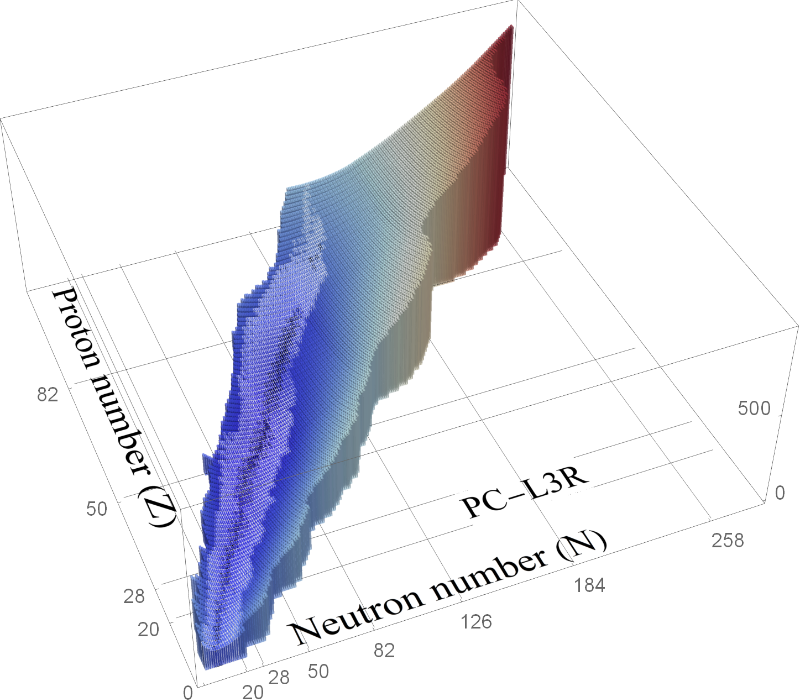Home / News / Latest News
02 02, 2024
New Study Predicts Properties of Undiscovered Nuclei and Border of Nuclear Landscape
With entering the era of new generation radioactive-ion beam facilities, the new facilities permit us to resolve previously challenging experiments in discovering new isotopes, in revealing the important physics related to these exotic nuclei far from the β-stability valley, and in deepening our understanding of the origins of the chemical elements in the Universe.
Recently, the researchers of the Institute of Modern Physics (IMP), Chinese Academy of Sciences (CAS) collaborated with Technische Universität München in using the covariant density functional theory to predict the existence of these exotic nuclei. The research outcome was published at Atomic Data and Nuclear Data Tables on February 1.
For confirming the existence of new isotopes and the limit of an isotopic chain, world-wide scientists need to determine the nuclear masses, radii, half-lives of these newly discovered isotopes. Nevertheless, scientists are restricted by the very constrained resources in performing experiments, and thus they have to prioritize which new isotopes are possible to be discovered or even to be remeasured in high precision. Therefore, a set of reliable theoretical predictions of the characteristics (physics properties) of new isotopes serves as a forefront guideline for experimentalists to explore the uncharted nuclear landscape.
Measuring the last bound nuclei of isotopic chains not only examines the state-of-the-art nuclear theory, but also advances our understanding of the extent of nucleosyntheses (syntheses of chemical elements) at the extreme astrophysical environment during neutron star mergers, core-collapsed supernovae, and X-ray bursts.
The covariant density functional theory is one of the most successful approaches for studying the nuclear structure. The theory describes the interactions among nucleons in the nuclear medium. The nucleon-nucleon interactions can be described in the form of either point-coupling interaction (assuming nucleons as point-like particles interacting with one another) or meson-exchange interaction (assuming nucleons as some constituents communicating with one another with passing the messengers – mesons).
In this new study, the researchers plugged in one of these interactions to the Relativistic Hartree-Bogoliubov approach to systematically explore the ground state properties of all isotopic chains from oxygen to darmstadtium. These properties consist of the binding energies, one-neutron and two-neutron separation energies, root-mean-square radii of matter, of neutron, of proton and of charge distribution, Fermi surfaces, ground-state spins and parities.
“In fact, exotic nuclei that potentially exhibit new phenomena provide testing ground for our understanding of quantum many-body system. Up to now, the existence of about 2500 nuclides have been experimentally proven. We expect new facilities are very promising in discovering more exotic nuclei and in unraveling the phenomena that we have never seen before. Also, matching theoretical predictions and experimental findings could be exciting for us to cross check our theoretical models,” explains PhD candidate LIU Zixin from IMP, first author of the paper.
Based on these ground state properties of nuclei, the drip line of neutron and proton, halo phenomenon, and new magic number problem were discussed in detail. The predicted properties can provide the corresponding guidance for future experiments and theoretical research in nuclear physics.
This work was financially supported by the Strategic Priority Research Program of CAS (No. XDB34020100), National Natural Science Foundation of China (No. 11775277), CAS President’s International Fellowship Initiative (No. 2019FYM0002), and the Deutsche Forschungsgemeinschaft (DFG, German Research Foundation) under Germany’s Excellence Strategy EXC-2094-390783311.

Figure. The 3D nuclide chart displaying the new isotopes predicted by the relativistic Hartree-Bogoliubov approach with the PC-L3R interaction. Experimentally confirmed isotopes (white region) and stable nuclei (black histograms in the middle of white region) are shown against the background of predicted isotopes. The height of each histogram represents the normalized mass excess of the predicted isotope. (Image by LAM Yi Hua and LU Ning)
Data availability: https://github.com/lamyihua/nuclear-ground-state-properties
Share Link (free access to the article before March 22, 2024): https://authors.elsevier.com/a/1iX2-,26popDOv
Contact:
LAM Yi Hua
Institute of Modern Physics
Email: lamyihua(a)impcas.ac.cn
Appendix(s):
Contact Information
Institute of Modern Physics
Email: lamyihua(a)impcas.ac.cn



 甘公网安备 62010202000713号
甘公网安备 62010202000713号


